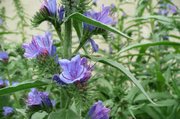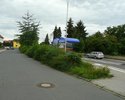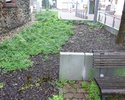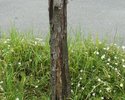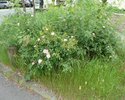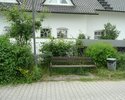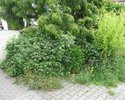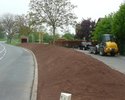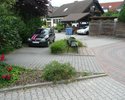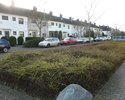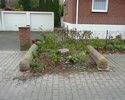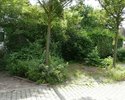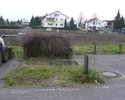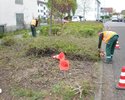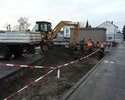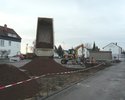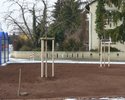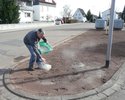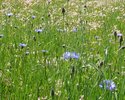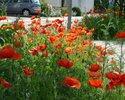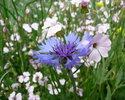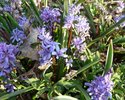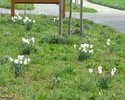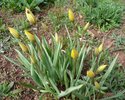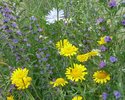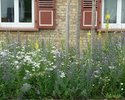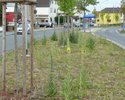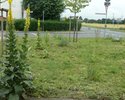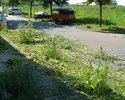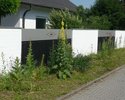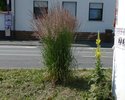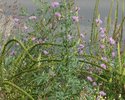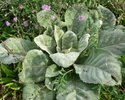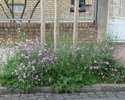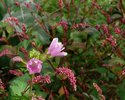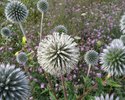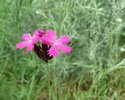Redesigning inner-urban public green areas in Riedstadt
Since autum 2009 the city of Riedstadt re-designs succesively inner urban green areas. The costs and labour for the maintenance had to be reduced while the ecological value was to be raised.
News
9. June 2020: As one output of the collaboration between the City of Riedstadt and the Technical University Darmstadt an article about the faunistic diversity as well as the maintenance costs of the inner urban green areas in Riedstadt was published in PlosOne. It's open acces and can be downloaded at PlosOne ("Flower power in the city: Replacing roadside shrubs by wildflower meadows increases insect numbers and reduces maintenance costs")
Previous state of inner-urban public green areas in Riedstadt
Following you can find some examples of how inner-urban green areas looked like before redesigning them: species poor, in bad maintenance and not really beautiful
As Riedstadt is one of the original members of the “Alliance of Communities in favour of Biological Diversity” (founded on February 1st, 2012), we decided on a way to change the inner urban green spaces that would reduce the costs for the tending as well as enhance biodiversity.
After removing the old shrubbery and the soil (which was often densely interspersed with weeds as for instance couch-grass (Elymus repens) due to the lack of maintenance) up to 50 cm depht we refilled the areas with a nutrient-poor soil-substrate, especially developed for the use in inner-urban areas. In places with trees we used a tree substrate, which contains more nutrients and meets the demands of trees in dry and hot cities.
After filling in the substrates and planting the trees we sowed the areas with seed-mixtures developed by ourselves, which comprised all in all about 100 perennial and annual species typical for our region (species of thermophilic and draught tolerant grasslands and field margins), including some of the Red List. Moreover all seeds were collected in Riedstadt and neighbouring communities by a company who specialized in the production of certified regional seeds - thus using genetical resources that are adapted to the ecological conditions here (further information here: Association of German wild-seed an wild-plant producers).
You can have a look at the mixtures here: mixture pilote-project and the slightly altered actual mixture, which contains less seeds of species that emerged too dominately (for instance parsnip Pastinaka sativa). Therefore we added some grasses and dispensed with all plants being or looking similar to thistles (e.g. musk thistle Carduus nutans) as they were not approved too warmly by the local inhabitants.
Following you can see some pictures from the construction phase:
Scientific Research
In order to assess the effects of the altered design of inner urban green the City of Riedstadt has been collabarating with different Universities.
Up to summer 2020 the following issues were analysed:
2013/2014: Master's thesis at the Justus-Liebig-University Gießen on "Vegetation in the City". The research focused on the vegetation (comparing re-designed with unchanged green areas) and the acceptance among the local population.
2015: Bachelor's thesis at the Technical University Darmstadt on "Effects of the restoration of inner urban green areas on ground-living arthropods"
2016/17: Bachelor's thesis at the Technical University Darmstadt on "Arthropod abundance and communities on inner urban green areas"
2018: Bachelor's thesis at the Technical University Darmstadt on "The Impact of the restoration of inner urban green areas on ant communities"
2019: Bachelor's thesis at the Technical University Darmstadt on "Effects of the restoration of inner urban green areas on cicada diversity"
2019: Bachelor's thesis at the Technical University Darmstadt on "The Impact of restored spaces on weevils in urban areas"
2019: Master's thesis at the Eberswalde University for Sustainable Development on "Varicoloured diversity in the City - strategies to enhance acceptance of native wild flowers in public areas"
9. June 2020: As one output of the collaboration of the City of Riedstadt with the Technical University Darmstadt an article about the faunistic diversity as well as the maintenance costs of the inner urban green areas in Riedstadt was published in PlosOne. It's open acces and can be downloaded at PlosOne ("Flower power in the city: Replacing roadside shrubs by wildflower meadows increases insect numbers and reduces maintenance costs")
100 permanent plots of 1 m x 1m were marked on inner urban green areas in Riedstadt, comprising old (unchanged) green areas as well as re-designed areas with restoration measures dating back to the years 2009/10 and 2015.
Maintenance - further development of the redesigned green areas
The newly designed areas are regularly mown two times a year by the local city workers. With the first cut - usually about the end of June - the swath is taken from the areas to prevent the accumulation of nutrients. Too much plant-available nutrients in the soil enhance some highly competitive species and thus lead to a loss of richness in species. The second cut is carried out in late autumn or winter, depending on the development of the vegetation. In order to lower the costs of maintenance this time the areas are mulched - which means that the vegetation gets mown, cut into small pieces and left on the areas. As the second growth usually is less abundant the so caused nutrient-enrichment is neglectable. The chosen form of maintenance is a compromise between the aim of enhancing biodiversity and the aim of reducing the costs for the tendance.
We could in fact reduce the costs for the maintenance from 5,52 € per square meter and year before to 1,19 € per sqm and year after redesigning the green areas.
While mowing, we always spare some large or attractively flowering plants so that the areas are never too bare - usually about 5 % of the areas are left unmown. Here you can see how the reshaped green spaces have developed since and how they are tended too:
Acceptance
From the very beginning the redesigning of the green spaces in the city was accompanied by a sometimes highly emotional discussion among the local politicians and population. Especially the pilote-project in Riedstadt-Erfelden was matter to a lot of requests and complaints. One reason for this was surely the fact that there was little time in between the decision to redesign (November 2009) and the start of the work (December 2009). So there was nearly no time left for public relations, for an extensive information of the local population. Furthermore, then the new instrument of sponsorships for public green spaces (see below) was not broadly known, yet.
In consequence, the local administration put a lot of effort into public relations when continuing the project in the other districts of Riedstadt, starting more than a half year in advance. Apart from general information in the local press and on the city's website every local resident was contacted and provided with information in a personal letter. Besides, open councils were held in all villages on which the administration and the mayor presented their plans and discussed them with the citizens. The representatives of the city pointed out the possibility of private sponsorships. When citizens make a commitment to tend to public green spaces they are free to take influence on how the green space for which they sign a private sponsorship is planted. Where this is not the case, the city administration desings the spaces according to their aims - enhancing biodiversity and reducing the costs - and seeds them with the particular flower-mixture (see above).
Private Sponsorships
The city administration enhances private sponsorships for public green spaces and looks for dedicated persons who help to make the city more attractive. Everyone, who lives in front of or near a public green area, is invited to take responsibility for the appearance of their surroundings. The local inhabitants who see the green spaces and the trees in their housing areas day-to-day can react much quicker to a lack of water, to overgrowing weeds or litter than the city-workers who have to tend to hundreds of such green spaces in the five villages that form Riedstadt.
So, in February 2010, the magistrate decided on general guidelines for private sponsorships for public green spaces. In prior agreement with the city administration the sponsors may influence the designing of "their" green space(s), having a wide range of possible alternatives: The green areas may just be left in the state they are in, they can be completely redesigned and newly planted - for instance with shrubs or herbaceaus perennials, with wild flowers or garden species, even with vegetables and salad, if the sponsors choose to.
At the beginning of the year 2017 there are 116 such private sponsors in Riedstadt tending to 149 public green spaces.
Contact for all concerns about the designing and maintenance of public green spaces
Matthias Harnisch (Fachgruppe Umwelt)
Stellvertretender Fachgruppenleiter, Projektleitung "Stromtalwiesen", Grünflächenmanagement, Baumkataster
Raum: 302 (3. Stock)
Telefon: 06158 181-322
E-Mail:m.harnisch@riedstadt.de
Text and photographs, where not marked otherwise:
© Matthias Harnisch, Stadt Riedstadt
Further use of text and pictures is not allowed without allowance and naming of the author(s).


